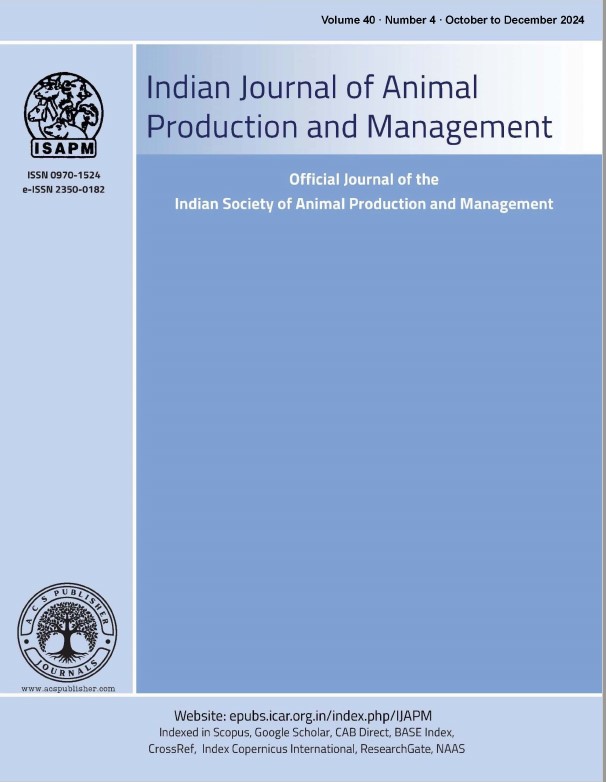A Study on the Effect of Housing on Physiological Responses of Nellore Lambs Kasala
DOI:
https://doi.org/10.48165/ijapm.2024.40.1.2Keywords:
Nellore lambs, slatted flooring, asbestos roofing, tree shade, physiological responsesAbstract
A study was carried out to find out the effect of housing on physiological responses of Nellore Jodipi lambs under tropical environmental conditions. Thirty weaned Nellore ram lambs of 3-4 months age were selected based on body weight (average initial body weight) and randomly divided into three groups of ten animals each. The lambs in Group-I were housed with morum flooring and asbestos roofing with tree shade, while Group-II lambs were housed with morum flooring and asbestos roofing without tree shade and Group-III lambs were housed with elevated slatted flooring and galvalume roofing without tree shade. Temperature and humidity values were significantly (P<0.05) different among all the groups. Lower mean maximum temperature (°C) values were observed in group III (35.53±0.28) when compared to group I (36.22±0.27) and II (37.29±0.25) and the lower average maximum relative humidity (%) was 69.59±2.92 in group III followed by group II (69.88±2.94) and I (70.65±2.96). The mean physiological responses viz., rectal temperature, respiration rate and pulse rate were significantly (P<0.05) lower in group III (102.38±1.00°F, 26.25±1.00bpm, 69.07±1.00beats/min.) when compared to group I (102.60±1.00°F, 31.60±1.00bpm, 82.10±1.00beats/min.) and II (102.85±1.00°F, 33.56±1.00bpm, 87.08±1.00beats/min.), respectively. It was concluded that the housing system of elevated slatted flooring with galvalume roofing proved to be effective in controlling heat stress and maintaining normal physiological responses for better growth performance of Nellore ram lambs.
References
Alhidary I A, Shini S, AlJassim R A M and Gaughan J B 2015. Physiological responses of Australian Merino wethers exposed to high heat load. Journal of Animal Sciences 90: 212-220.
Bharambe V Y and Shinde S S 2014. Effect of different housing systems on performance of osmanabadi kids in Konkan region of India. Indian Journal of Small Ruminants 20(2):132-
Germani Adrian, Munoz-Osorioa, Armando Jacinto Aguilar-Caballeroa, Luis Armando Sarmiento Francoa, Maria Wurzingerb and Gustavo Augusto Gutierrez-Reynosoc 2016. The effect of two housing systems on productive performance of hair-type crossbreed lambs in sub-humid tropics of Mexico. Journal of Applied Animal Research 45 (1): 384–388.
GOI, Ministry of Agriculture, Department of Animal Husbandry, Dairying and Fisheries Livestock census, 2012. All India Report, Krishi Bhavan, New Delhi.
Indu S, Sejian V. and Naqvi S M K 2014. Impact of stimulated heat stress on growth, physiological adaptability, blood metabolites and endocrine responses in Malpura ewes under semiarid tropical environment. Animal Production Science 55(6): 766-776.
Kalyan De, Davendra Kumar, Anoop Kumar Singh, Kamal Kumar, Artabandhu Sahoo and Syed Mohammed Khursheed Naqvi 2017. Effect of protection against hot climate on growth performance, physiological response and endocrine profile of growing lambs under semi
arid tropical environment. Tropical Animal Health Production, DOI 10.1007/s11250-017- 1307-7.
Liu H W, Cao Y, and Zhou D W 2015. Effects of shade on welfare and meat quality of grazing sheep under high ambient temperature. Chinese Academy of Sciences, Jilin 130012, China, 2015.
Koubkova. M, i. Knizkova, p. Kunc, h. Hartlova, j. Flusser, o. Dolezal 2002. Influence of high environmental temperatures and evaporative cooling on some physiological, hematological and biochemical parameters in high-yielding
dairy cow. Czech Journal of Animal Science 47(8): 309–318.
Meenakshi Sundaram S, Sivakumar T, Ramesh V and Tensingh Gnanaraj P 2002. Comparative performance of Madras Red Sheep under different management systems. Indian Journal of Animal science 72(10) : 904-907.
Pathak P K, Roychoudhury R, Saharia J, Borah M C, Dutta D J, Bhuyan R and Kalita, D 2018. Impact of seasonal thermal stress on physiological and blood biochemical parameters in pigs under different dietary energy levels. Tropical animal health and production 50(5): 1025-1032.
Rahman I M K Abdel, P K Nagpaul and Bhupider Singh 2013. Effect of two different shelter systems on milk yield and composition, feed intake, feed conversion efficiency and physiological responses in lactating crossbred goats during summer season. Egyptian Journal of Sheep and Goat Sciences 8(1): 81-87.
Rahman I M K Abdel, P K Nagpaul and Bhupider Singh 2013. Effect of two different shelter systems on milk yield and composition, feed intake, feed conversion efficiency and physiological responses in lactating crossbred goats during winter season. Egyptian Journal of Sheep and Goat Sciences 8(1): 89-94.
Sawan D Rathwa, Vasava A A, Pathan M M, Madhira S P, Sedhiya M G, Gori H P and Pande A M 2018. Assessment of Hematological, Biochemical and Hormonal Status of Indigenous Sheep during Hot and Cold Dry Season. Indian Veterinary journal 95 (01): 46 – 48.
Sejian V, Maurya V P, Kumar K and Naqvi S M K 2013. Effect of multiple stresses on growth and adaptive capability of Malpura ewes under semi-arid tropical environment. Tropical Animal Health and Production 45: 107-116.
Sreedhar S and Sreenivas D 2015. Changes in physiological responses of sheep under different housing systems in tropical environment. Veterinary Research International 3(4): 124-
Srikandakumar A, Johnson E H and Mahgoub O 2003. Effect of Heat stress on respiratory rate, rectal temperature and blood chemistry in Omani and Australian merino sheep. Small Ruminant Research 49: 193-198.

